Seshore Life
As you walk along the seashore there are all sorts of wildlife to be found, much of it that will not be found inland. Some plants are only found near the sea as they are specially adapted to living on shingle. Seabirds feed on creatures that are only found in the sea or along the shore. Then there is all the wildlife that lives actually in the sea or within the intertidal zone. A walk along the shore can be very rewarding. More information about the shells that can be found washed up along our beach can be seen on the Sea Shells page.
Seabirds
Our stretch of shore is not really suitable for breeding seabirds so on a typical visit you will not see many different species. Many different birds fly along our stretch of coast and a few will rest here briefly, but unless you are a regular birdwatcher you are unlikely to spot many. The most common birds you are likely to see are shown here.
Herring Gull
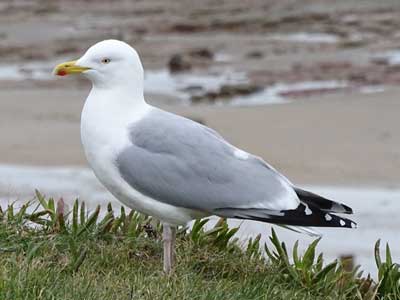
The most common gull along our stretch of coast, they can always be seen along the shore and will always scavenge in waste bins when the opportunity arises.
Black-headed Gull

Almost as common as the Herring Gull, but a little smaller, they are very distinctive in the summer. However the black head fades to white in the winter, all except for a small dot on each side of the head.
Great Black-backed Gull
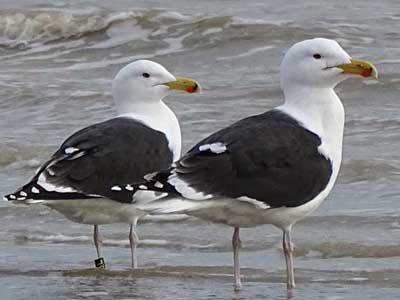
Larger than a Herring Gull, and with a distinctly black back, these gulls can sometimes be seen along our shore.
Cormorant

These large black seabirds can often be seen perched on any handy structure along the shoreline and have a habit of spreading their wings to dry. They can sometimes be seen diving for fish. They also roost in trees around the pool near Pebsham Farm.
Turnstone
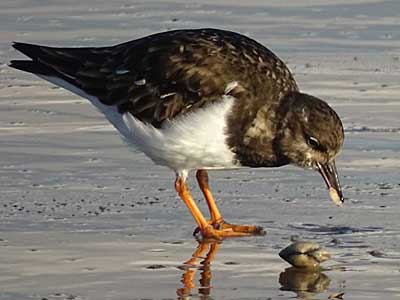
The commonest wader along our coast, the Turnstone can often be seen in small flocks hunting for insects, crustaceans and molluscs. About the size of a blackbird, it has very distinctive black and white wing markings when in flight. The Turnstone is a winter visitor but some non-breeding birds stay throughout the summer.
Oystercatcher
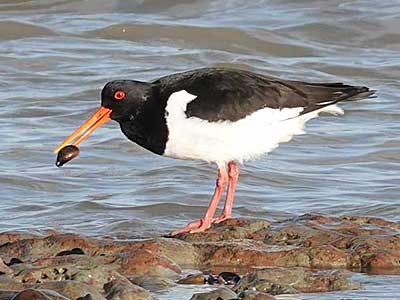
About the size of a pigeon, the Oystercatcher has a long orange-red bill, which it uses to probe for food, and a distinctive white wing stripe in flight. Oystercatchers are resident all year but are more common along our shore in the winter where they can often be found with Turnstones.
Plants
Many of the plants that can be found along the shore can also be found inland, but the first two shown below are shingle specialists. Vegetated shingle is a fragile ecosystem and is protected as it is internationally rare, so please be careful not to damage any of the plants growing on the shingle.
Sea Kale
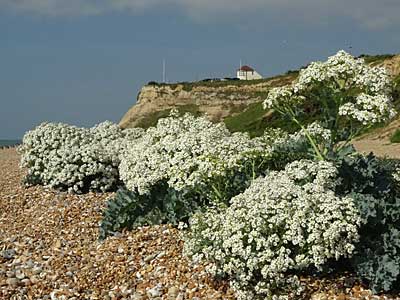
This plant has very long roots that search for fresh water flowing through the shingle, which they help to stabilise.
Yellow Horned Poppy
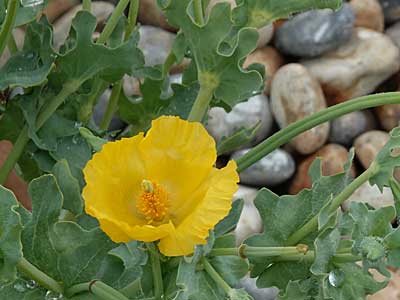
Another shingle specialist that is well established along our stretch of the shore.
Hottentot Fig
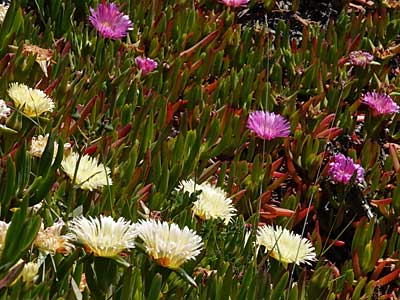
This invasive alien is well established along the cliffs at Galley Hill where it occurs in both the pink and yellow forms.
Alexanders
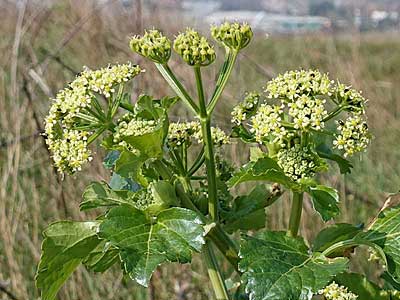
A plant brought to England by the Romans as an edible plant, although it has now fallen out of favour. On the cliffs at Galley Hill.
Vipers Bugloss
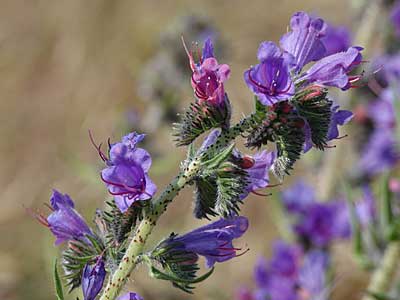
Grows happily on the shingle near to some beach huts.
Tree Mallow

This is growing just below the cliffs near Galley Hill.
The Strandline
The Strandline is the area just above the high tide line where all sorts of things get washed up on the beach by the sea at high tide. This line is not static, but migrates up and down the beach as the tides alternate between spring and neap with the lunar cycle. Consequently you may find several lines of debris down the beach. The strandline is a good place to look for shells. The shells likely to be found along our shore are shown on the Shells page.
Common Starfish

Starfish can be found in the rockpools and are occasionally washed up onto the seashore. This Common Starfish feeds on mussels and oysters.
Hornwrack

Hornwrack looks like a seaweed but is actually a Bryozoan composed of a colony of tiny animals called zooids that feed on even smaller organisms. When fresh it smells of lemons.
Barrel Jellyfish

Jellyfish sometimes get washed up along the shore. This Barrel Jellyfish was upside down, about 30 cm across and has 8 thick tentacles. Jellyfish stings can be painful so don’t handle any you find.
Crab Shell

As a crab grows it has to moult as each shell is a fixed size. Consequently it backs out of the shell leaving all the hard parts behind. The soft crab is then extremely vulnerable until it has swollen by about 20% and developed new limbs and shell.
Mermaids Purse

Sharks, Skates and Rays lay eggs on the seabed and sometimes the empty egg cases get washed up on the shore. Commonly known as mermaids purses.
Cuttlebones
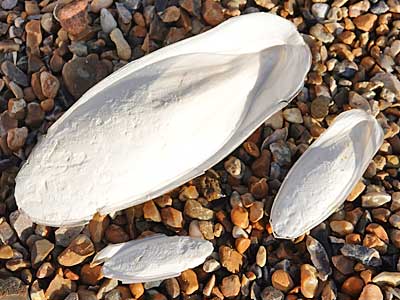
These are the internal bones of the Cuttlefish, used to give it buoyancy. Commonly used as a dietary supplement for caged birds they can also be carved to make molds for casting jewelry.
The Intertidal Zone
As the tide goes out a whole range of sealife is exposed that normally lives beneath the surface but can survive for a few hours out of the water or in a shallow rock pool.
Common Mussels
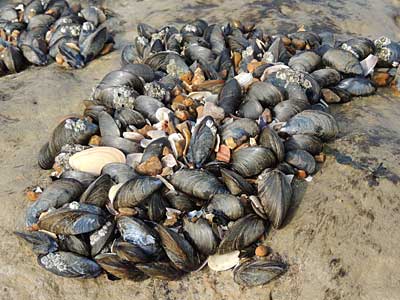
The Common Mussel grows in abundance on the rocks and is a favourite food of many seabirds.
Common Limpets
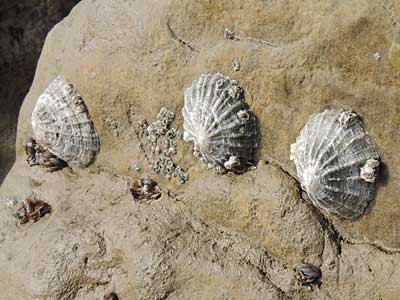
Limpets are renowned for the strength of their attachment to rocks and groynes. They possess a ‘radula’ which is like a scraping tongue which they use to scrape algae off rocks.
White Piddocks
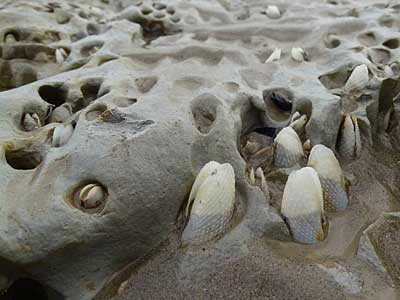
Piddocks burrow into soft rock to protect their rather brittle shell. Only its siphon protrudes from the burrow so that it can feed. There are several places along the shore where old Piddock shells have been exposed as the rock has worn away.
Acorn Barnacles
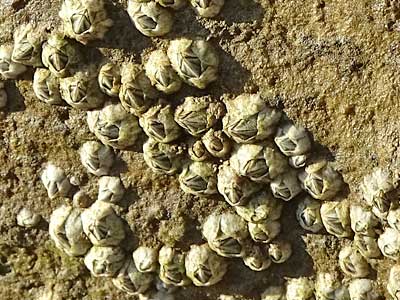
These tiny barnacles colonise anything that doesn’t move so some groynes and rocks virtually disappear under a colony. Although they look a bit like small limpets they are in fact crustaceans related to crabs and lobsters.
Periwinkles
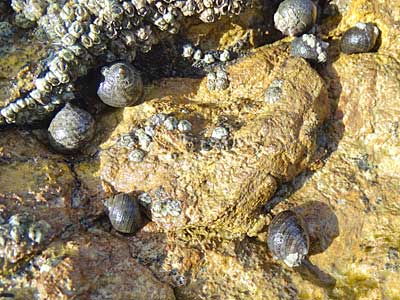
These winkles are close to some barnacles on whose larvae they will feed, although their main food is seaweed and other algae.
Flat Top Shell
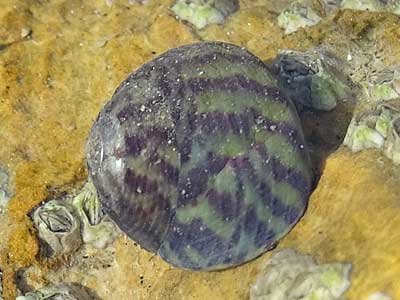
More often found on the western shores of the UK, this Flat Top Shell can be seen in our rock pools. The purple stripes fade if the shell dries out between tides.
Beadlet Anemone

These sea anemones can be found in the rock pools and clinging to any structures uncovered at low tide. Out of the water they withdraw their tentacles and close up, as two of these have. They can appear red, brown, green or orange.
Sand Mason

The Sand Mason is a worm that burrows into the sand. It constructs a feeding tube, often covered in sand and shell fragments, which sticks out of the sand to provide a protective shelter.
Seaweed
Seaweed grows on the seabed and although many can be found at low tide lying flat on rocks, at high tide they form an underwater forest stretching up towards the light. At low tide some can be found in the many rock pools, where they look most natural. Seaweeds are marine algae and are split into three main groups by colour; red, brown and green. One of each group is shown below.
Polysiphonia sp.

This red seaweed can be found in many of our rockpools and is one of a number of seaweeds of the genus Polysiphonia that are difficult to distinguish. They don’t have common names.
Spiral Wrack
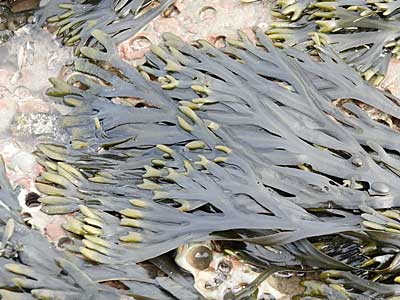
This brown seaweed is often washed up on the beach. Unlike the similar Bladder Wrack it has no gas bladders, but the fronds tend to twist, hence its name.
Gutweed
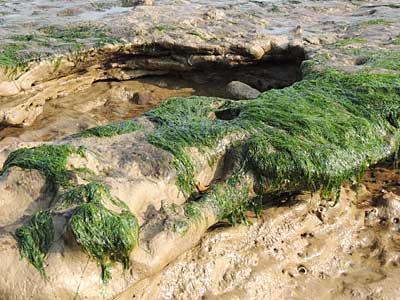
This green seaweed is commonly seen attached to the rocks on our shore, forming great mats of slippery grass-like weed.
More Information
Information about many of the creatures of the seashore can be found at www.theseashore.org.uk
A useful book is the RSPB Handbook of the Seashore.
Photos on this page by Peter Hunnisett

